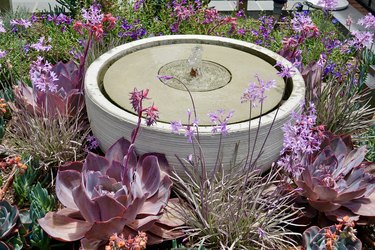
Over time, a painted resin fountain left outdoors may fade and otherwise become a bit more grungy due to exposure to the elements. Instead of buying a new fountain, repaint it using a spray paint specifically designed for plastics. Cleaning it thoroughly first is the key to getting the paint to adhere.
Cleaning the Fountain
Video of the Day
Unplug and empty the fountain and then use a rag to wipe off any gunk or mildew stuck to it. Spray off the resin with a powerful blast from a garden hose if it's an outdoor fountain to help loosen debris or set it in a plastic tub or utility sink to clean it if it's made for indoor use. Fill a bucket partway with warm, soapy water and then dip in a nylon-bristle scrub brush and scrub the fountain. If it's more of a decorative indoor tabletop fountain, be sure to keep any areas dry that require it, such as a power jack or even the bottom of the unit. Wait for the fountain to dry completely before attempting to prime or paint it.
Video of the Day
If the fountain has some old paint on it that's coming off, use fine-grit sandpaper to remove any paint that might flake off on it own. Sanding also helps the new primer or paint stick to the fountain better, especially on any areas that appear shiny or glossy. Wipe down the sanded areas with a damp cloth afterward to remove any residue.
Choosing the Right Paints
Paint that's made for plastic also sticks to resin. Spray paints, such as Krylon Fusion All-in-One, are perfect for getting between raised details and into recessed elements on any designs built into the resin fountain shape. Other spray paints may also work well, but be sure the label says the paint works on plastic. Another option is to use a spray primer made for plastic and then switch to a standard spray paint. Some products double as a primer, such as the aforementioned Krylon paint, so there's no need to buy two separate products.
For smaller details, such as bird or flower designs outside the fountain, acrylic craft paints come in handy over the top of the main fountain paint color once the spray paint dries. If you already have spray paints in the desired colors for minor details, spraying a small amount into a plastic lid and then dipping a brush into it allows you to brush on the paint as you would with a craft paint.
Most common paints aren't meant for use under the water, and they may not adhere for long in the water-containing portion of the fountain. If you intend to paint the area that sits underwater, either try the regular plastic spray paint and just plan on repainting that part of the fountain once in a while or look for a specialty paint, such as a type made for ponds and pools. Those paints are usually expensive and a bit over the top for a small decorative resin fountain.
Painting the Fountain
Select a well-ventilated area, ideally outdoors on a nonwindy day. Lay some scrap cardboard or an old tarp to set the fountain on. Move any items nearby that may accidentally get sprayed with paint or just set up a box quite a bit larger than the fountain as a spray booth to contain all the paint spray as you work.
If using a spray primer, the process is the same as for a spray paint. Shake the primer or paint can for a minute or so and then spray across the fountain, starting each spray burst just a little before the fountain and ending a little after it. If you can't easily walk around the fountain, as may be the case if it's in a makeshift spray booth, rotate the fountain as needed by grabbing an unpainted portion of it. Continue until the entire piece is coated and wait for it to dry for a little while, following the time recommendations on the can's label. Apply a second coat and allow it to dry completely before handling it.
Add minor details as needed using acrylic craft paint or a different color of spray paint sprayed into a disposable container or the paint can lid to use as a dipping pot. Use an aptly sized artist's brush to paint details, such as flower petals or spots on a ladybug. A sealer isn't needed in most cases, but read the paint label for recommendations just in case the company does suggest applying a sealer on items used outdoors.